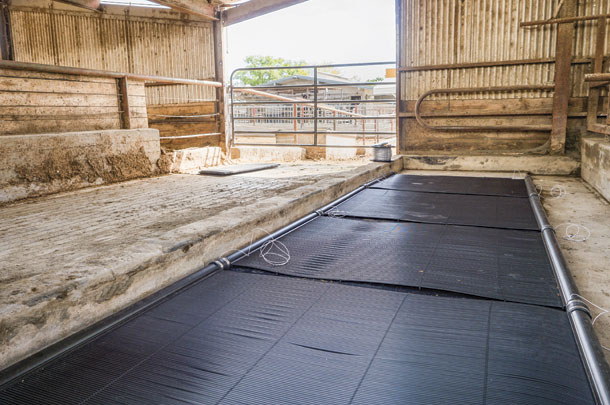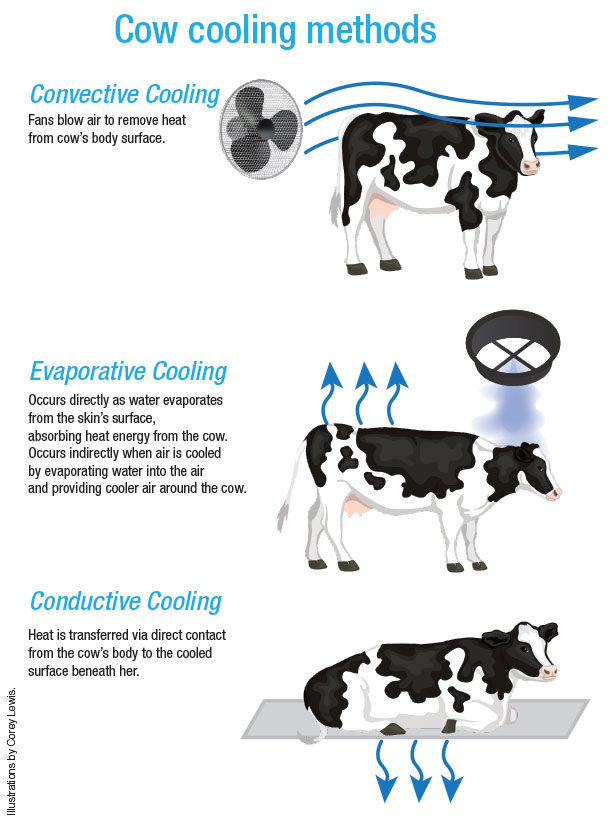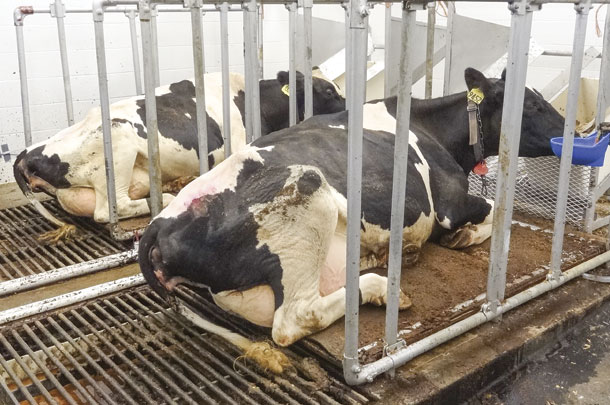Configurations of fans and misters or soakers are commonly the cooling systems on dairies, but two universities are trying to find alternative methods to reduce both energy and water use without compromising cow comfort.
When combined, convective and evaporative cooling can be an effective heat abatement strategy. However, the University of California – Davis and Cornell University are trialing conductive cooling. Research teams are experimenting with cooling cows from the bottom up through direct contact with a chilled surface.
University of California – Davis research
In 2017, the California Energy Commission funded a project to study the use of a conductive mat for cooling cattle as a possible solution to reduce dairy farm energy use. It was led by Cassandra Tucker, a professor and animal welfare researcher, and a team of engineers at the Western Cooling Efficiency Center at University of California – Davis.

In the UC-Davis study, water-cooled mats were buried beneath the sand-bedded freestalls, using both Holstein and Jersey cows as subjects. Mats were programmed to begin cooling when the bedding temperature reached 66ºF. Respiration rate, body temperature and milk production were monitored on 32 head.
“Early indicators are: The mats don’t seem to work as well (as methods currently used),” Tucker says. Elevated respiration and heart rates, along with increased body temperature, were recorded. “We are trying to figure out why they didn’t work as well by watching the video recordings. Were the cattle not lying on the mats at those times of day when they were stressed? We don’t yet know why the mats didn’t work as well.”
Promising elements of a conduction cooling system include the potential for cleaner animals and bedding in the absence of misting systems, decreased water use and the potential to recycle water used in the conductive cooling system for other uses. There was also less energy used to operate the system; however, final calculations and overall savings have yet to be finalized.
Tucker’s observations last summer are providing insights unrelated to the treatment mats but significant to cattle heat stress. “We can see the change in respiration rate before we see a change in body temperature,” Tucker says. “The cows will actually show us they have the onset of heat stress early on. We have the potential to prevent the changes in milk production if we catch the symptoms early enough through use of electronic monitoring devices.”

A second aspect of the project funded by the commission looked at ducts delivering air cooled by evaporation combined with low-rate water soaking at the feedbunk. They also compared what they call an “optimized” baseline where cows were was cooled with soakers at half-rate and the fans were moved from the freestalls to over the feedbunk.
They moved the fans to move more air over cows while they were guaranteed to be wet and encourage more evaporation and heat loss. Soakers and coolers came on at 72°F. Respiration, body temperature and milk production indicated that the cows did not experience heat stress in either of these options. However, the system with the fabric ducts and cooled air used more energy than the cooling mats and both baselines.
Tucker found promise in the fact only half the water was used in the optimized baseline experiment to achieve the same outcome. Small tweaks such as fans at the feed lane helped take advantage of evaporative cooling opportunities through better timing during the day and pairing water cooling with air movement.
Dry climates with less humidity seem to be best suited for evaporative cooling tools; however, Tucker indicated the principle of increasing opportunities for evaporation has the potential to work in all parts of the country. One of the novel systems will be tested commercially in 2018 or 2019.
Cornell University research
Kristy Perano, doctorate candidate at Cornell University’s Department of Biological and Environmental Engineering, has also been studying the effectiveness of cooling mattress systems, finding slightly different results in a more humid climate.
Eight cows were subjected to heat stress in a heated environment, then four were moved to cooling mattresses, while the other four did not receive the mattress treatment. Physiological responses were monitored on all animals.

“We measured the surface temperature when the cow was lying down on the mattress and the water temperature when it went into the mattress and when the cow left,” Perano says, estimating the mattresses transferred 27 percent of the cow’s body temperature.
Bedding depths and condensation studies appropriate to a New York climate differentiated her study from Tucker’s work in California. Perano found a minimum 1 inch of bedding is the breaking point to minimize condensation, but 2 to 3 inches of bedding was required to maintain a 1-inch average over the mattress.
While deep bedding with 6 inches of sand eliminated condensation, it completely offset any benefit from the cooling mattress.
While the closed-loop system conserves water, chilling it requires a lot of energy. “I don’t see it as a way to reduce energy cost but possibly as a way to aggressively cool cattle in hot climates or as an alternative way to reduce water use,” she says.
Encouraging cows to lie down and lack of conflict with other systems are advantages Perano sees with conductive cooling.
The big downside is cost, and the investment may not be justifiable for Northeast climates. ![]()
PHOTO 1: At the University of California – Davis, feedbunk water cooling was combined with targeted convective cooling. Photo by Paul Fortunato of the Western Cooling Efficiency Center.
PHOTO 2: Rubber conductive cooling mats were installed in the sheltered lying area, which were then covered with sand and had cooled water running through them at UC – Davis. Photo by Paul Fortunato of the Western Cooling Efficiency Center.
PHOTO 3: Cows relax on cooling mats during conductive cooling methods research on cattle at Cornell University. Photo by Kristy Perano.
ILLUSTRATION: Illustrations by Corey Lewis.
Bev Berens is a freelance writer based in Michigan.







